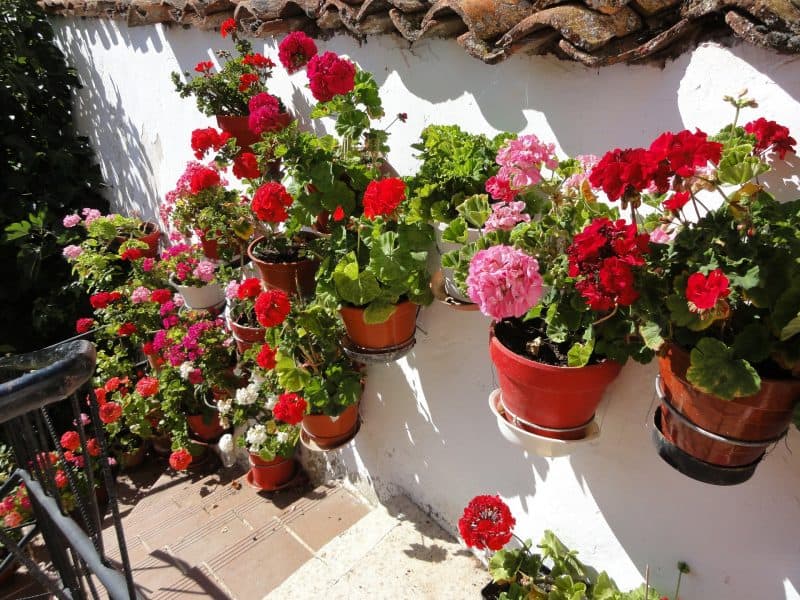
From its rich cultural history to its ever-changing landscapes and fantastic gastronomy, the region of Andalucia is guaranteed to leave no visitor indifferent.
As if that weren’t enough, it’s also famed for its award-winning white villages – or pueblos blancos. These beautiful little towns are scattered throughout the region and provide the perfect base for a peaceful mini-break or a day trip from one of Andalucia’s main cities.
If you’re busy planning a road trip through Andalucia or are looking for inspiration for places to visit in the South of Spain, TOMA & COE have used our insider knowledge to bring you our pick of the best villages in the region.
1.) Seville: Cazalla de la Sierra
The province of Seville boasts arguably the most beautiful city in Andalucia as its capital, meaning few visitors ever venture beyond its enchanting city centre. But for those who are intrepid enough to explore the landscape surrounding it, the province has a great deal to offer.
The town of Cazalla de la Sierra, situated in the heart of the Sierra Norte national park, can be found a little over an hour’s drive from the city of Seville.
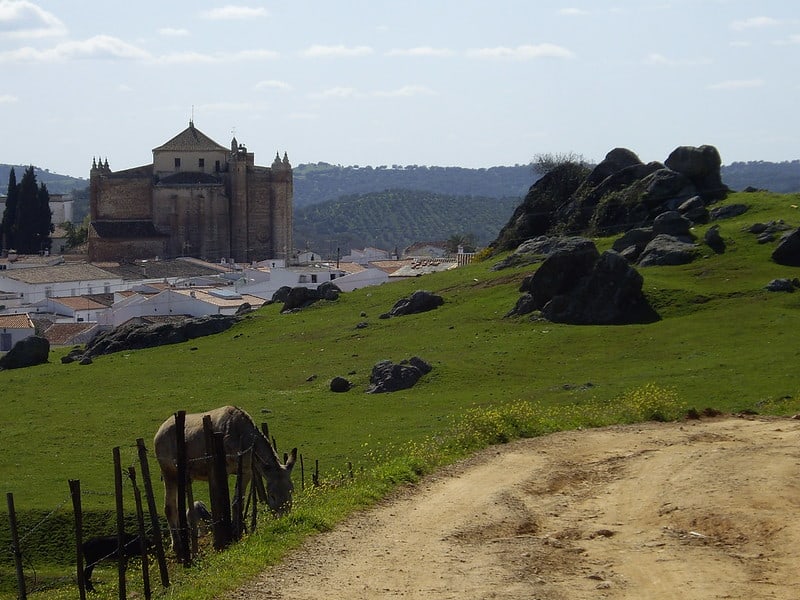
This pretty town boasts some of the most outstanding examples of religious architecture in Spain, amongst them the Iglesia Parroquial de Nuestra Señora de Consolacion, a stately church heralding from the 14th century.
The town is also famous for its sweet morello cherry and aniseed liquor, and its acorn-fed Iberian pigs, which are said to produce some of the best jamón in Spain.
Keep an eye out for other traditional dishes such as roasted game, wild deer and partridge. Fresh truffles are also often seen on the menu in this part of Andalucia.
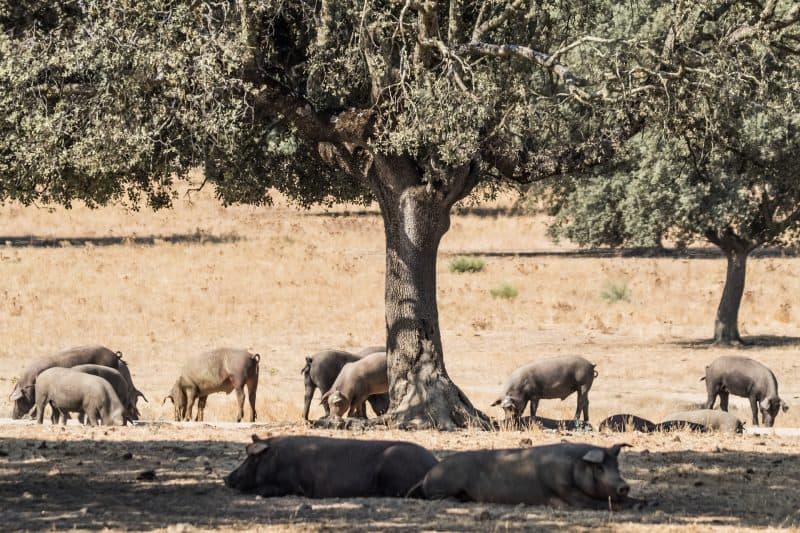
What to do in Cazalla de la Sierra
Try some local liquor: A guided tour of the Bodegas Miura, located in a converted monastery, costs five euros with liquor tasting throughout. Find out more here.
Go hiking: There is a range of excellent walks in the national park surrounding Cazalla de la Sierra.
Where to Stay
Located at the entrance of Cazalla de la Sierra, remarkable rural hotel El Palacio De San Benito abounds in opulent, old-world charm.
Housed in a converted 15th-century convent, this 4-star hotel has a variety of sumptuously decorated rooms on offer, each bestowed with individual names – amongst them the grandly titled “King’s Room” and the “Matador Room”.
The hotel also boasts a music room, a library, an in-house restaurant and an abundance of outdoor space – including a central patio complete with whispering fountains, and an outdoor swimming pool.
Contact
Address: Paseo del Moro, 41370 Cazalla de la Sierra, Sevilla
Tel: +34 954 88 33 36
How to get to Cazalla de la Sierra
Public transport options are limited from Seville to Cazalla de la Sierra, so your best bet is to hire a car and drive. It will take you approximately 1.20h.
2.) Cadiz: Medina Sidonia
Cadiz province is known for having some of the best beaches in Spain. Its silky white sands, rolling dunes and turquoise waters make it the perfect summer holiday location for locals and visitors alike.
But venture inland and you’re in for a treat, too, as the province is also home to some of the most beautiful pueblos blancos in Spain.
Awarded the title of “Most Charming Village” in 2018, the town of Medina Sidonia is perched on a hillside overlooking flat plains stretching towards the coast.
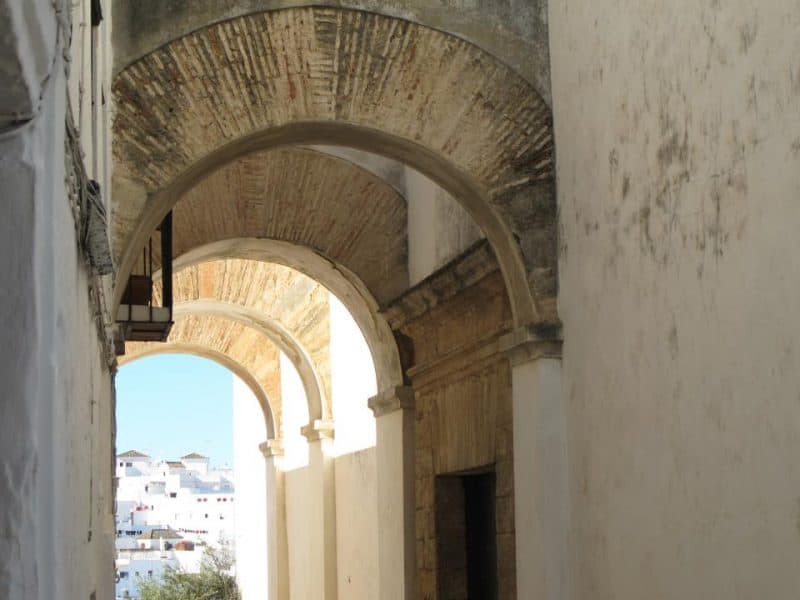
It was historically used as a defence location due to its elevated position and is believed by some to be one of the oldest towns in Spain.
This picturesque white village oozes authentic Andalucian charm: a haven of tiny, meandering streets lined with elegant townhouses, their balconies overflowing with vivid geraniums.
The lovely town centre is also scattered with stone arches dating back to Roman times, marking the entrance to the more ancient parts of the city.
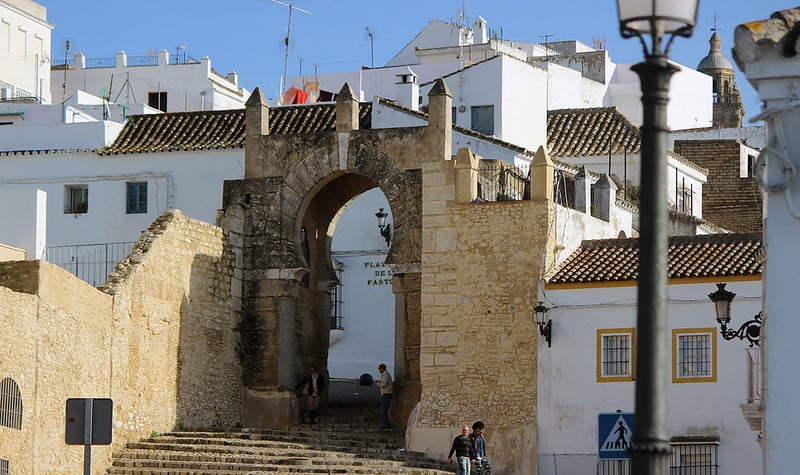
What to do in Medina Sidonia
Dine out with a view: For panoramic views of the surrounding land, head to La Vista de Medina restaurant, opposite the Santa Maria de la Coronada church. There are spectacular vistas on show from the comfort of the restaurant’s terrace and windowed dining room. With a bit of luck, you’ll able to glimpse the ocean on a clear day.
Hang out with the locals: Check out Medina Sidonia’s beautiful main square, Plaza Mayor, surrounded by fantastic local restaurants with a buzzing atmosphere, especially on weekends.
Discover the underground city: Medina Sidonia is strewn with relics from its Roman past. On offer for perusal are the immaculately preserved remains of a Roman road or a museum where you can explore the relics of a roman sewage system in a labyrinth of tunnels beneath the town.
Where to Stay
Situated between Medina Sidonia and the nearby white village of Vejer de la Frontera is gorgeous boutique hotel Casa La Siesta.
With only 8 guests rooms and wraparound views of the surrounding countryside, this small hotel is the perfect spot for a secluded weekend or a romantic getaway.
Rooms are spacious and comfortable with thoughtful interior design touches such as vaulted ceilings with exposed wooden beams and freestanding bathtubs perfect for a long, relaxing soak.
Casa Siesta also boasts an excellent in-house restaurant with a seasonal menu largely sourced from the hotel’s own kitchen garden and a private wine cellar!
Contact
Address: Camino de los Parralejos, s/n, 11150 Vejer de la Frontera, Cádiz
Tel: +34 956 23 20 03
How to get to Medina Sidonia
From the coast of Cadiz, Medina Sidonia is half an hour drive inland by car.
You can also opt to take the bus from Cadiz bus station, which departs at regular intervals throughout the day and takes just over an hour.
3.) Malaga: Gaucín
Malaga is a popular destination amongst holidaymakers due to its famous sunshine coast and fabulous year-round weather. But there is more to the province than its bustling beaches and temperate climate.
Situated inland from the coast is the whitewashed village of Gaucín. Nicknamed the “balcony of Europe”, this gorgeous town boasts incredible views of Gibraltar and North Africa from its vantage point at 626m above sea level, overlooking the River Genal valley.
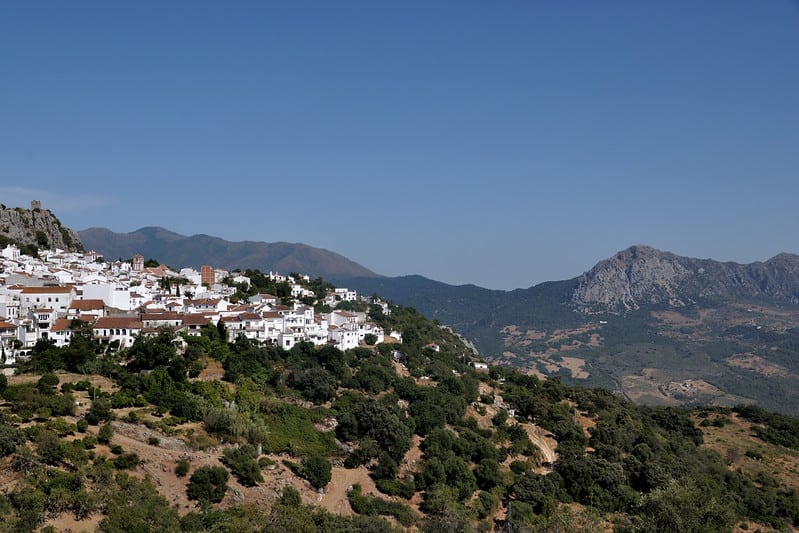
What to do in Gaucín
Check out the local wildlife: Gaucín is a mecca for birdwatchers. Trek up to the aptly named Castillo de La Aguila – castle of the eagles – and keep your eyes peeled for eagles winging the skies above. Kestrels can also be glimpsed nesting in the walls of the convent. There are informative plaques dotted around the town to give you the low down on the village’s population of migrating and native birds.
Pay your respects: Burial plots don’t have to be morbid, and Gaucín’s well-kept cemetery is truly something to behold. In accordance with common practice in Spain, remains are kept in niches in the wall rather than underground. The vertical graves are adorned with flowers and artfully inscribed plaques. The graveyard also boasts some of the most stunning views in the village.

Where to Stay
Beautiful boutique hotel La Fructuosa is situated in the centre of Gaucín in an elegantly converted townhouse, which boasts enviable views across the valley below.
La Frutosa is co-owned by Belgian artist Catherine- whose private gallery adjoins the main building- which accounts for the numerous quirky design touches to be found throughout the hotel.
Each of the six rooms is decorated with a different theme – from the Sea Room with its aquamarine hues to the Garden Room with its intricately patterned wallpaper and spectacular views.
The hotel also has a fabulous in-house restaurant – located in a converted wine cellar which still contains many of its original features- and a pretty terrace ranged with outdoor tables for guests to enjoy during the warmer months.
Contact
Address: Calle Luis De Arminan 67, 29480, Gaucín, Andalucia, Spain
Tel: +34 617 692 784
How to get to Gaucín
It’s an intimidatingly long journey from the Costa del Sol to Gaucín via public transport, so your best bet is by car. It will take you just under 1.30h to drive there.
4.) Granada: Montefrío
The sheer diversity of its landscapes makes Granada one of the best destinations to visit in Spain. The province has something for everyone: from the snow-capped mountains of the Sierra Nevada to the warm Mediterranean waters of its subtropical coastline.
Granada city itself hosts some of the most beautiful monuments in Spain, including the awe-inspiring Moorish palace of the Alhambra.
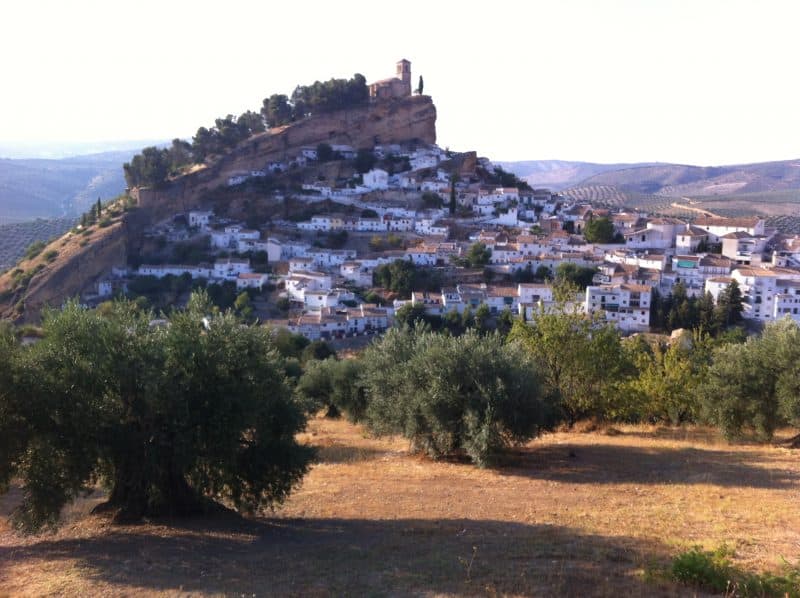
It’s also well worth exploring some of the charming villages dotted throughout the province, amongst them the hillside town of Montefrío, which literally translates as “the cold hill”.
Situated in the northwestern corner of the Granada province, near the Cordoba border, this small town cuts a striking silhouette against the surrounding landscape.
Perched on a craggy outcrop of rock above the spread of white houses below is the 14th-century church, Iglesia de la Villa, which is built in the remains of a Nasrid castle.
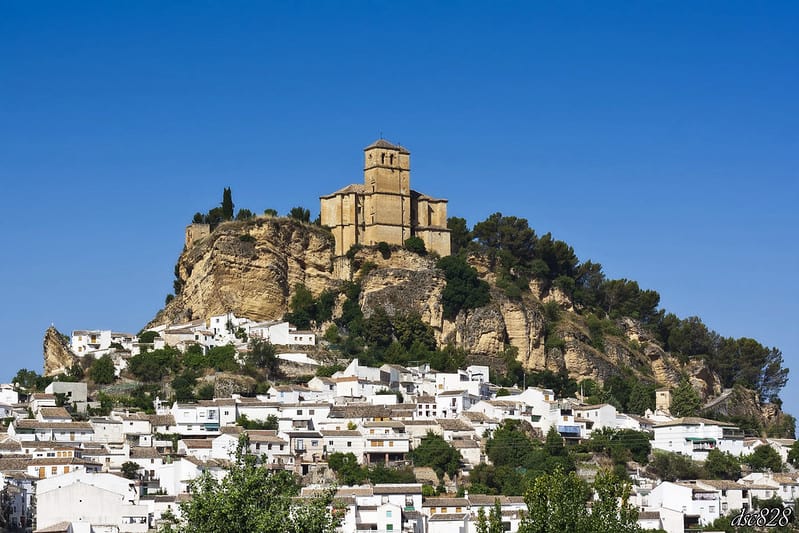
Those who brave the steep climb to the top of the rock will be rewarded with panoramic views of the region from its summit.
Montefrío is also famous for its large gypsy population, making it the perfect spot to take in some flamenco in a local tablao.
What to do in Montefrío
Visit an ancient settlement: A short drive out of the village will take you to Peña de Los Gitanos, an ancient Neolithic human settlement. Situated on private land, the owner offers guided tours of the site. Find out more by clicking here
Try local produce: Montefrío is famous for its cured sausages, chorizo and black pudding, known as morcilla. Be sure to sample some in a local bar.
Visit the churches: In particular, the round church, Iglesia de la Encarnacion, which was inspired by the Pantheon in Rome. This remarkable building is an absolute must-see.
Where to stay
Situated a stone’s throw from the famous Iglesia de la Encarnacion church, self-catering accommodation Monteftur provides an ideal base in Montefrío.
Located in a renovated townhouse in the centre of town, guests can choose between self-contained apartments or en-suite private rooms – all of which spotlessly clean and impeccably decorated in soothing, neutral tones.
Some rooms even come complete with their own terraces with views of the church’s famous domed roof.
Contact
Address: Plaza Pilillas 118270 MontefríoSpain
Tel: +34 639 33 84 39
How to get to Montefrío
Montefrío is 50 minutes from the city of Granada by car.
ALSA buses also run a route from Granada bus station to Montefrío, which takes 1.30h in duration.
5.) Jaen: Úbeda
The province of Jaén is the heart of olive growing country in Andalucia. The region’s trees account for half of Spain’s yearly production of olive oil.
Often referred to as “the gateway of Andalucia”, Jaén boats an abundance of national parkland and verdant farming country. The region’s largest national park, Sierras de Cazorla, is covered in dense pine forest and is rich in wildlife such as bearded vultures and red deer.
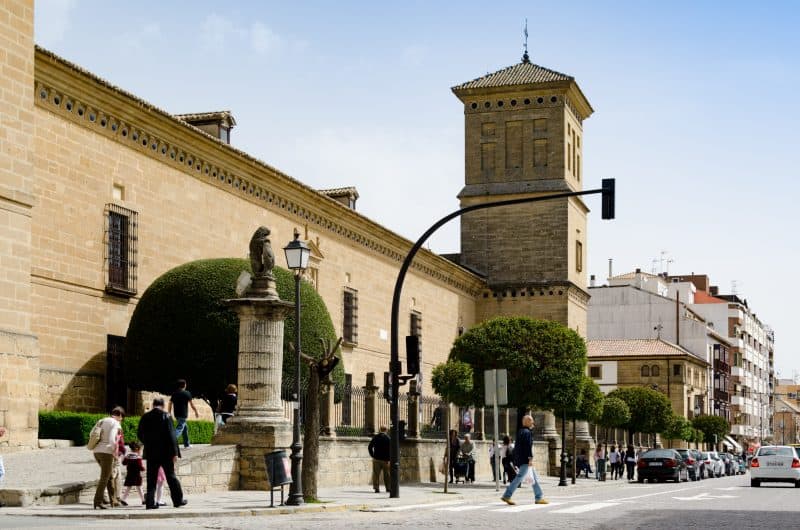
Jaen is also spoilt for beautiful towns, such as Úbeda, which is recognised as a UNESCO world heritage site alongside its neighbouring village, Baeza.
Úbeda abounds with examples of Renaissance style architecture, amongst them the 16th-century Hospital de Santiago with its sweeping interior courtyard, graceful arches and intricate facade, now used as the town’s conference hall.
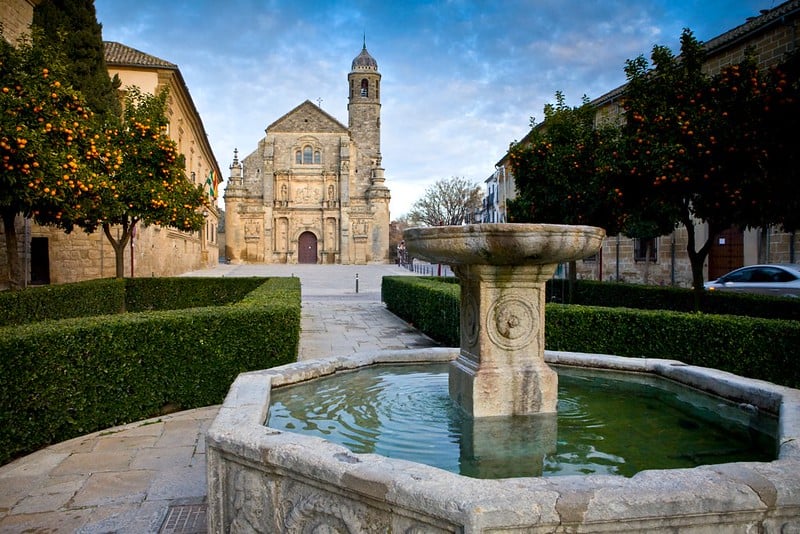
Úbeda is also home to one of Spain’s most ancient synagogues, the atmospheric “Synagoga de Agua”, believed to date from the 14th century.
Situated in a series of shadowed chambers below street level, the existence of the synagogue was stumbled upon in 2006 by a businessman who had bought the upstairs property to convert into tourist apartments.
What to do in Úbeda
Explore the secret synagogue: Learn more about the remarkable Sinagoga del Agua on a guided tour, costing from 4 euros per person. It is also a destination on TOMA & COE’s Sephardic Heritage Tour.
Visit a chapel: Check out chapel Sacra Capilla de El Salvador, considered a flagship of Renaissance architecture. Commissioned in the 14th century by Francisco de los Cobos y Molina to act as his family’s private funeral chapel, the fascinating building is now open to the public and well worth a visit.
Where to stay
Luxurious 5-star hotel Palacio de Úbeda is situated in the centre of the town – a short walk from the most popular monuments.
Located in a beautifully renovated building which still contains an abundance of original features – such as a spacious interior courtyard with pillars -every room in this stylish hotel oozes understated charm.
Guests can choose between the classically elegant deluxe suites, junior suites and the exclusive Conde Suite – which comes complete with a sumptuous freestanding bathtub and panoramic views of the town.
The hotel also boasts a rooftop terrace with a cocktail bar and swimming pool and its very own spa – where guests can book themselves in for a range of relaxing treatments.
Contact
Address: Calle Juan Pasquau, 2, 23400 Úbeda, Jaén
Tel: +34 953 81 09 73
How to get to Úbeda
It takes 1hr on an ALSA bus to get to Úbeda from the city of Jaén.
By car it can be reached in just over 40 minutes.
6.) Almería: Mojácar
The province of Almería is famed for having some of the best beach towns in Spain. Its miles of picturesque coastline is blessed with crystal clear, Mediterranean waters and relatively unspoilt wild beaches, many of which have been awarded blue flag status for excellence.
Almeria is also home to the spaghetti western. Its arid planes and craggy mountain peaks provided the perfect backdrop for many famous Hollywood films, amongst them A Fistful of Dollars and The Good, the Bad, and the Ugly.
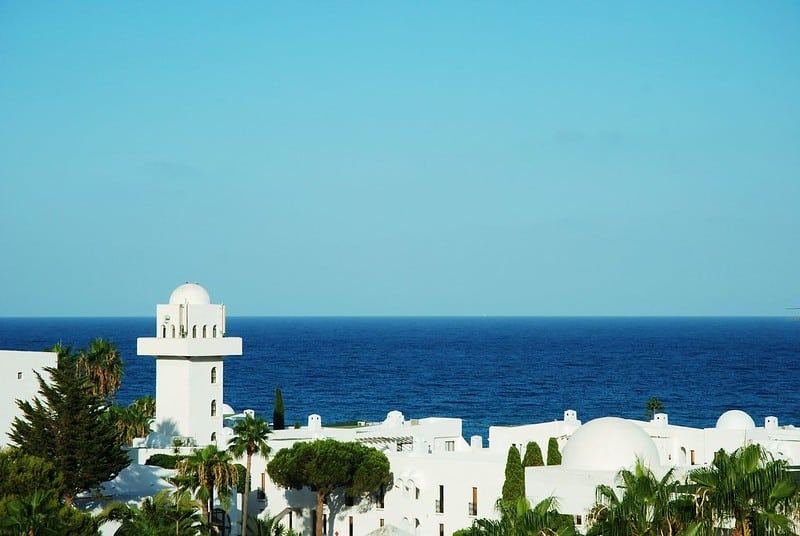
The province also hosts Mojácar, declared one of the prettiest villages in Spain in 2003. Mojácar, which derives its name from the word “Monxcar” – meaning “holy mountain”- is situated on a hilltop 170 metres above sea level.
The town is split into two parts: Mojácar Pueblo and Mojácar playa, which boasts 7km of blue flag awarded virgin beaches.
A half-hour walk up the hill brings you to the charming town of Mojácar itself, with its stacked whitewashed houses looking out across the pristine beaches below.
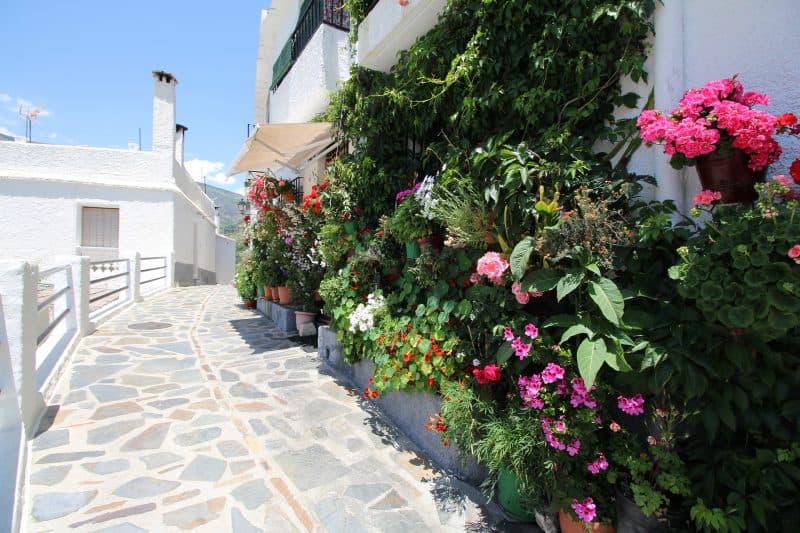
The village is steeped in over 1000 years of history, spanning back to the bronze age. Mojácar was subsequently occupied by Phoenicians, Carthaginians, Greeks and Romans until its eventual conquest by the North African Moors at the close of the 15th century.
What to do in Mojácar
Get a feel for local living: Check out the quirky little museum Casa de la Canana. This 200ft square house mimicking the traditional style of a “Mojáquera” abode, complete with traditional village clothes and tools dating back to the beginning of the 19th century.
Where to stay
Due to its diminutive size, accommodation in Mojácar Pueblo is limited – with most visitors preferring to stay in the beach resort of Mojácar Playa instead.
But for those hoping to escape the crowds of the coast and base themselves within the village, boutique hotel Olivar Hostal is a fantastic option.
Nestled in the heart of the picturesque old town and owned by Italian couple Alberto and Miki, this cosy little hotel offers a real home-from-home feel.
Rooms are bright, airy and simply decorated and range in size from triples to doubles – some of which include private balconies and mountain views.
There’s a large sun terrace for guests to enjoy, plus a spacious breakfast room and even an in-house sauna!
Contact
Address: Calle Estación Nueva, 11, 04638 Mojácar, Almería
Tel: +34 950 47 20 22
How to get to Mojácar
Mojácar is an hour’s drive from Almería city. It can also be accessed by ALSA bus from Almeria station, at a journey time of 1.30h.
7.) Córdoba: Castro del Río
The province of Córdoba is well known for its sweet white wines, baroque churches and famous flower-filled patios.
The city of Córdoba itself houses one of the most important examples of Moorish architecture in the entire Islamic West: the iconic Mesquita de Córdoba, a sprawling mosque enclosed within the perimeters of the city’s ancient walls.
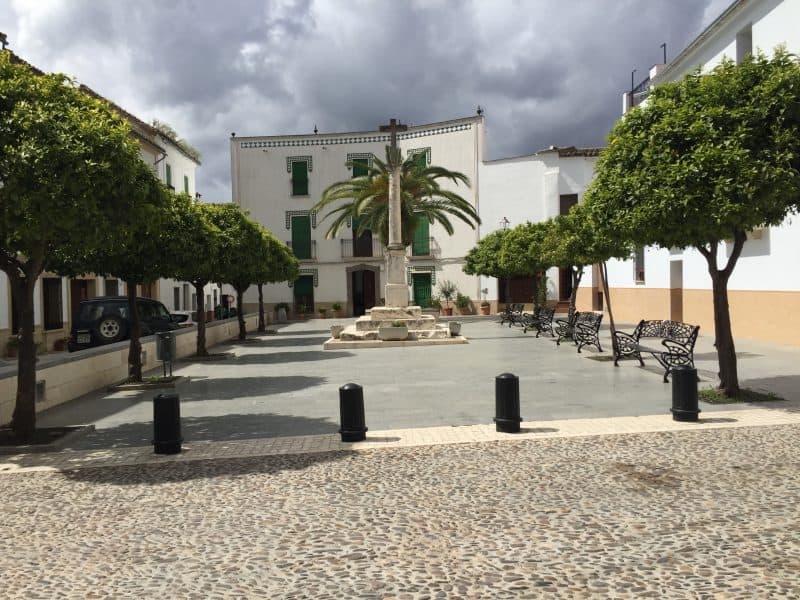
Nestled in the countryside to the South East of Córdoba Province is the pretty town of Castro del Río. A stop on the world-famous pilgrimage, The Camino de Santiago, this village is overflowing with gorgeous churches and even has its own castle, Castillo Fortaleza, which was first constructed in the 14th century.
It’s also famous for exporting furniture made from olive wood to destinations as far-flung as Japan.
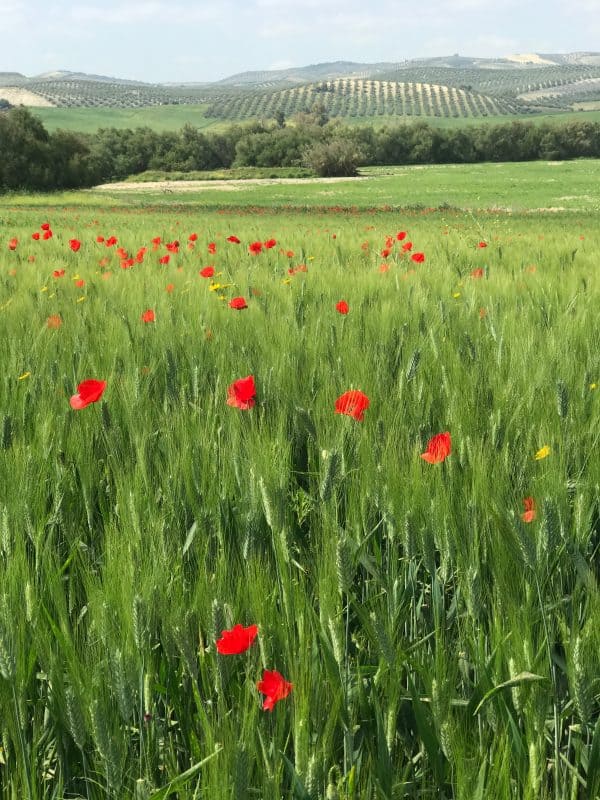
What to do in Castro del Río
Have a wander around its churches: Be sure to check out the Parroquia de la Asunción church, located in the top part of the town and rumoured to be built on the ruins of a former mosque. Inside it boasts a wealth of sculptures, paintings and intricately carved gold displays.
Where to stay
If you’re planning a big group getaway, then spectacular rural farmhouse Hacienda Secadero Viejo is the perfect place to base yourself.
This sprawling country house has room for up to twenty guests spread throughout five bedrooms and is idyllically located in the countryside a 2-minute drive outside Castro del Río.
Guests at Secadero Viejo are granted private access to the entire property during their stay, which includes a large farmhouse kitchen with an open fireplace, a spacious living room and an expansive outdoor area with its own swimming pool (complete with waterfall!) and barbeque.
Contact
Address: Calle los Molinos, 14840 Castro del Río, Córdoba
Tel: +34 633 43 64 44
How to get to Castro del Río
Castro del Ro is less than an hour’s drive by car from the city of Córdoba.
Autocares bus service runs a route between Cordoba and Castro del Rio, which takes just over 40 minutes.
8.) Huelva: Almonaster la Real
The province of Huelva, located on the Western edge of Andalucia and bordered by Portugal, is often overlooked as a tourist destination, but there’s plenty on offer for those who wish to explore.
The region is made up of diverse landscapes: a long Atlantic coastline with wild, unspoilt beaches combined with sprawling national parks comprised of pine woods and saltwater lagoons.
Huelva also has its fair share of charming white villages. Amongst these is the picturesque town of Almonaster la Real.
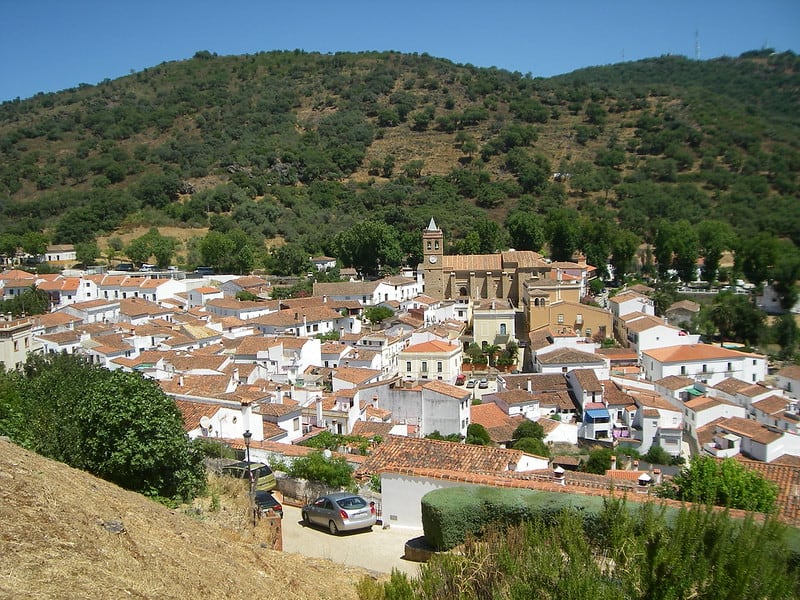
Situated on the edge of a National Park and surrounded by forests of cork trees, this sleepy town is also home to a hilltop mosque – a must-see monument for all visitors to the town. This incredible example of Islamic architecture dates back to the 10th century and is encircled by the scattered ruins of a former castle.
Almonaster la Real has charm by the bucketload: the white walls of its houses are splashed with bright tendrils of bougainvillaea flowers, and the national parks of Sierra de la Aracena and Picos de Aroche provide a stunning backdrop of rolling meadows, woodlands and undulating hills.
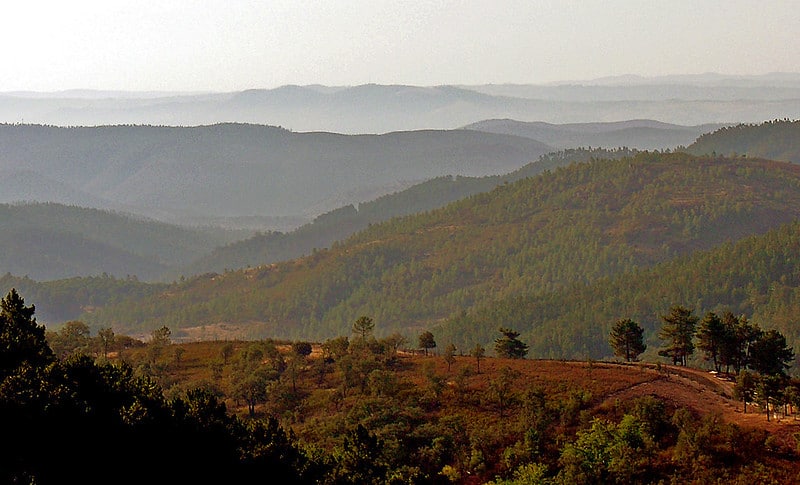
What to do in Almonaster la Real
Go for a hike: Almonaster la Real is surrounded by amazing hiking trails for walking enthusiasts. If you’re feeling particularly sprightly, a trek up Cerro de Cristobal above the town will provide you with some of the best views in Andalucia.
Sample the local cuisine: Try some local delicacies, such as the famous cured ham from nearby Jabugo. Other typical dishes include hearty poultry stews, garlic fried breadcrumbs known as migas, and potatoes with chorizo. This part of Spain is also famous for its gambas blancas – or white prawns – which go perfectly with a glass of cold beer.
Where to stay
Rural B&B Finca Buenvino is flung out in the cork forests of the natural park, a 25-minute drive from Almonsater la Real.
Owned by friends of TOMA & COE Sam and Jeannie Chesterton, this idyllic country estate is split between a five-bedroom B&B and two self-catering holiday cottages with private gardens and a swimming pool.
There’s also the option of enrolling on a cookery course during your stay, led by Sam and Jeannie’s talented chef son Charlie!
Contact
Address: 21208 Los Marines, Huelva
Tel: +34 59 12 40 34
How to get to Almonaster la Real
Almonaster la Real is an hour and a half drive from the city of Huelva.
There is one bus a day from Huelva bus station to Almonaster la Real, departing at 15h. The journey takes two hours.
Alternatively, visitors can hop on a train from Huelva to Almonaster Cortegana. From the station, it’s a five-minute taxi drive to Almonaster Real.
Let TOMA & COE plan you the perfect white villages road trip with our Self Guided Tours. For more information click here.
Short on time? Visit some of Cadiz’s most beautiful towns on our Escorted White Villages day tour.













